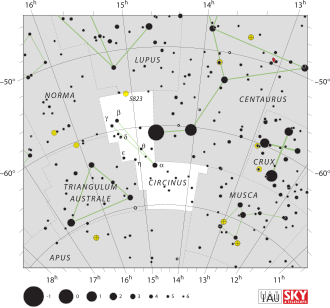Circinus
One of the 88 IAU constellations. The constellation was taken over in the 1920s.[1]
It was invented in Cape Town in the early modern era, when the Cape Colony, the settlement around the Fort de Goede Hoop (Castle of Good Hope) slowly grew. At that time, the place was a way-station for European ships to the archipelago now called Indonesia where tobacco, copper and iron was traded with the Khoekhoe clans of the region in exchange for fresh meat and other important travelling implements.
Etymology and History
In the 16th century, the Dutch cartographer Plancius commissioned two ship navigators to bring back star charts from the East Indies exploration - they formed the constellation ‘Southern Triangle’ (Triangulum Australe) under the Centaur, which consists of four stars similar to the classical Greek constellation of the triangle: one on each point and another in the centre of the baseline of the isosceles triangle. Between this and the centaur's hoof, there was a gap into which the French astronomer and surveyor Nicolas de Lacaille squeezed the figure of a circle around 160 years later. The constellation consists of three stars intended to represent the slender folded drawing tool. He may well have symbolised one of his most important daily tools here.
Lacaille named the constellation in French Le Compas and grouped[2] them together with Norma (his invention) and the Southern Triangle (Triangulum Australe) invented earlier by the Dutch.
Incidentally, the stars of Circinus were already visible and above the horizon in ancient times. However, due to precession and their proper motion, they would have been shifted so that the more northerly of the two legs of the compass would have passed through α Centauri. For ancient astronomers, the figure would therefore have been unclear and implausible even if we could show them our current view: The brightest star is only 3.2 mag, the other two are at 4 and almost 5 mag, so that they appear very inconspicuous against the background of the Milky Way and next to the bright Centaurus stars.
Image Gallery
Indigenous Constellations in this Area
In this area adjacent to the third brightest star of the night sky, Indigenous cultures have not named individual stars (other than α and β Centauri). The main star of the constellation Circinus, α Cir, has hence been nameless.
The South African people of the Khoekhoe[3][4] who lived in the area at the time when the constellation was invented, have named the two bright stars "the eyes of the beast" (Xami Di Mura), where the beast (xami) is a lion and the two eyes are "mura". If the two bright stars are imagined the eyes, the face of this creature is seen in the adjacent areas, covering also the star α Circini.
The language groups of Khoe and San cover a wide range each. Most of these languages are now moribund. The Khoekhoe dialect /Xam is one such language which was fortunately recorded, however there are no speakers surviving.
IAU WGSN Catalog of Star Names
In 2024, it was suggested to use the Khoe term "Xami" (from the /Xam dialect) to designate the 3.19 mag-star α Circini (SIMBAD) with a term from one of the peoples who are native to the place where the constellation was invented. This star was named Xami in 2024.
Weblinks
- South African Astronomical Observatory (SAAO) in Cape Town.
References
The information on the identification of Xami with this area in Centaurus was provided by Suki Lock (SAAO), based on information supplied by Auke Slotegraaf, Themba Matomela, Thembela Mantungwa and Mdumiseni Nxumalo. Sivuyile Manxoyi initiated the project of researching the Khoekhoe/ San sky culture after discussions with Prof Jarita Holbrook and Prof Kevin Snedegar on African Cultural astronomy, cf. also Bleek and Lloyd (1911)[3].
- ↑ Ian Ridpath's Star Tales (online edition on Circinus).
- ↑ Ian Ridpath's Star Tales (on grouping online edition)
- ↑ 3.0 3.1 Wilhelm H. I. Bleek and Lucy C. Lloyd (1911). Specimens of Bushman Folklore, London: George Allen.
- ↑ John Parkington, Janette Deacon, David Morris, Katriena Swartz, Sophia Adams, Dawid Abrahams, Serena Renier, Klaas Priega, Neil Rusch, Simon Hall, José Manuel de Prada-Samper, Pam Christie, Russ Taylor (2021). Karoo |xam-ka !au and |xam Cosmos, SAAO+SARAO, Cape Town.









